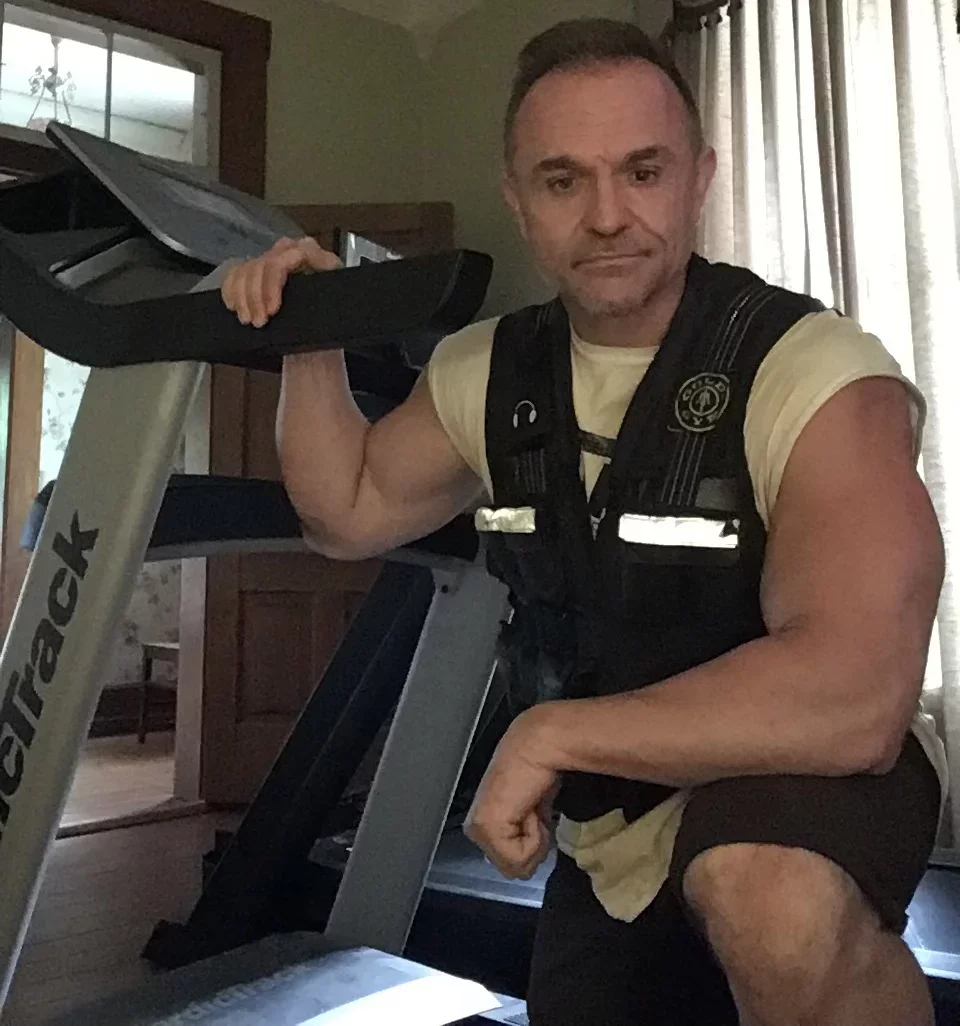Why Do I Want A Weighted Vest?
Competing annually in NPC bodybuilding contests since 2012, my trusty 45-pound weighted vest has become a tool of the trade. Season after season, whether cutting or bulking, I use it at least three times per week and love the results. Why a weighted vest for cardio? Because it cuts the fat like a hot knife through butter and below I’ll explain why. It also helps when developing pull-up and push-up strength for the same reasons. Frankly, it’s just common sense and you’ll wonder why you didn’t picked one up years ago, but perhaps you’ve just never thought about it. In 2025, I need every advantage I can get when training.

This 45-pound weight vest I bought in 2010 has been a great workout partner for both cardio or strength training.
Backed by science, the strategy makes sense whether using treadmills, ellipticals, or simply exercising on the ground. Weighted vests are available for sale online or at most retail stores that carry sporting goods. A couple key points you’ll want to keep in mind when using one with a treadmill, make sure you don’t exceed the maximum weight capacity of that particular machine, and keep the flooring beneath your unit in mind. Otherwise, if you’re looking to burn more calories fast, a weighted vest is the way to go.
What Are Weighted Vests?
You’ve probably seen these items in the sporting goods stores and wondered what they were. Designed in a wide array of styles, a quick Amazon search will generate tons of examples. Most of these vests are made of nylon and contain pouches for sandbags or metal plates. Other vests have plate horns and straps to secure small Olympic plates. Styles vary for men, women, and youth, and most are adjustable for users of different heights and bodyweights. The resistance level offered can range anywhere from 2.5 to well over 100 pounds depending on the style. Military fans can check out the design of tactical vests fashioned like those used as body armor.
I bought my 45-pound Gold’s Gym vest back in 2010 at a Walmart store and they’re also at Academy Sports outlets. Thirteen years and a lot of rainy runs later, it’s still hanging tough. My vest uses sandbag pouches and has a snapable belt around the waist, as well as a chest slot for an iPod. I have to say this unit and most I’ve seen are incredibly tough in terms of material. Over the years I’ve thrown mine in the backseat of my car and truck, as well as worn it while jogging trails in the woods amid rain. So long as you use it, you’ll definitely get your money’s worth.
How Do Weighted Vests Help With Weight Loss?
When looking to lose weight, the old rule of thumb is to burn those calories. One pound of fat equals about 3,500 calories. To lose one pound, you need to expend at least 3,500 more calories than you consume. Everybody has a different Basal Metabolic Rate (BMR), which is the amount of energy expended while at rest in a neutral environment. As a rule, the more active you are, the higher your BMR is. But another key factor is your own bodyweight. How many pounds you carry while exercising makes a big difference in the number of calories you burn while working out. Consider the following example of two different individuals and the number of calories burned per exercise session, based on their bodyweight.
- Activity: Jogging
- Pace: 3 miles per hour
- Distance: 5 miles
- Bodyweight: 150 pounds
- Calories Burned: 409
- Bodyweight: 195 pounds
- Calories Burned: 516
If your bodyweight is 300 pounds, then while wearing a 45-pound weighted vest you’re actually carrying 345 pounds into the exercise routine. A 300-pound jogger pacing 3 miles per hour for 5 miles actually burns 795 calories, while a 345-pound person burns 914. Now you start to get the idea of how a weighted vest can help you lose weight in a hurry. During my prep for bodybuilding contests, I typically cut from around 200+ pounds to 165-170 between January and May. Using weighted vests has always been one of my strategies for cardio.

What Do Studies Say?
Fear not. It’s not just anecdotal evidence at play here. A 2006 study published in Medicine and Science in Sports and Exercise titled “The effect of weighted vest walking on metabolic responses and ground reaction forces,” analyzed during treadmill walking: Oxygen consumption, exercise intensity, vertical ground reaction forces, and loading rates. Ten adult subjects performed standardized walking tests on a treadmill while wearing four different weighted vests at 0%, 10%, 15%, and 20% of their body mass. The results were clear, using weighted vests not only increased the metabolic rate and relative exercise intensity, but increased the load borne by the skeletal system while walking on a treadmill.

Above is a typical before-and-after shot for my bodybuilding competitions. During this 4-5 month period I’ll drop from over 200 pounds to down below 170.
In the 2019 article “New Tool to Control and Monitor Weighted Vest Training Load for Sprinting and Jumping in Soccer,” published in the Journal of Strength and Conditioning Research, researchers test the relationship between weighted vest loads and performance indicators in sprinting and jumping, such as V-max scores, maximum height and velocity. The goal of the study was to find that sweet spot in terms of weighted vests and the question, how much weight should I use to train? The actual weight of the vest used will vary by the size of the user as well as the goal, it seems.
It’s clear that wearing a weighted vest while exercising will increase the load carried and thus force your body to work a little harder, not only burning more calories along the way, but increasing your overall level of fitness.
A Few Points to Consider
Too much of a good thing can be bad for you. If you use too heavy a weighted vest while walking or running, you’ll feel it in your knees for sure. The good thing about adjustable weight vests is you can take a few sandbags out if that’s the case. Going into the routine, plan on working your way up in terms of time and weight. You won’t just strap on a heavy vest and run six miles at the start. My normal walk-around weight is about 200 pounds, and 45 pounds is 22.5% of that. The studies I’ve seen suggest that’s at the high end of the recommended usage. By the time I cut down to 175ish for competition, that same 45-pound vest is about 26% of my body mass. The 10-15% zone relative to body mass seems to be the preferred spot for most people. That said, I also use my vest while performing pull-ups and push-ups and over the years my body has become accustomed to carrying that load.
The second thing treadmill and elliptical users need to consider the size of their machine. Each machine has a maximum user weight which can vary from 250 to 500 pounds. We’ve reviewed the best treadmills for heavy people here and you’ll want to make sure your machine can handle the load you’re bringing. I use a NordicTrack Commercial 1750 for a lot of my training and it has a maximum weight capacity of 300 pounds, meaning I’m in the clear. You’ll notice that the extra weight can cause a little deck-and-belt-damaging clanging and banging on the treadmill if it’s not big enough to handle it, in which case, I’d recommend incorporating incline/decline training like hiking into the treadmill workout. Hiking up a 12% incline at even 3 miles per hour while wearing a weighted vest will cause you to break a sweat and set your quads on fire.
A third point of consideration is treadmill placement. The harder you train, the more important it is to consider the flooring beneath the unit. You’ll definitely want to get a mat to place beneath the machine if this is your plan.
Frequently Asked Questions
Are weighted vests dangerous?
Too much of a good thing is always a problem. If you suffer knee of hip pain, be sure to consult a medical professional before using a weighted vest as it will add more stress to your body. That said, weight vests can be adjusted from 0 to over 100 pounds so you can always personalize yours.
Are weighted vests expensive?
You'll find the price varies widely based on style and number of pounds included.
Can I juse a weighted vest on my rower or bicycle?
Be sure to check the maximum user weight on those machines before trying. Also be careful about using a weight vest on a road bike as it might affect your balance. You probably won't get as much benefit as you will with a treadmill or elliptical because the weight isn't being carried on your feet in the same way but it will help.
Other Treadmill Reviews:
- Amazon Big Spring Sale 2025 for Treadmills
- About: Brian Boyce
- Best Treadmills for Home
- Test HomePage
- NordicTrack Commercial X14i
- Echelon Stride
- NordicTrack C 590 Pro
- Sole TD80 Treadmill Desk
- NordicTrack Commercial X11i
- NordicTrack T 8.5 S - Pros & Cons (2025)
- Horizon Elite T5
- ProForm Pro 1000
- Exerpeutic TF1000
- NordicTrack T 6.5 S - Pros & Cons (2025)
- ProForm Sport 5.0
- ProForm Premier 900
- ProForm ZT6
- NordicTrack FreeStride Trainer FS5i (Discontinued)
- Bowflex Max Trainer M5
- BowFlex TreadClimber TC100
- ProForm Power 795
- ProForm Sport 7.0
- NordicTrack Incline Trainer X15i
- LifeSpan TR3000e Electric Folding
- NordicTrack C 1650 Treadmill
- Horizon Elite T9
- Official Boston Marathon Treadmill 4.0
- NordicTrack Treadmill Desk
- NordicTrack C 1630 Pro
- NordicTrack C 970 PRO
- Bowflex TC20 TreadClimber
